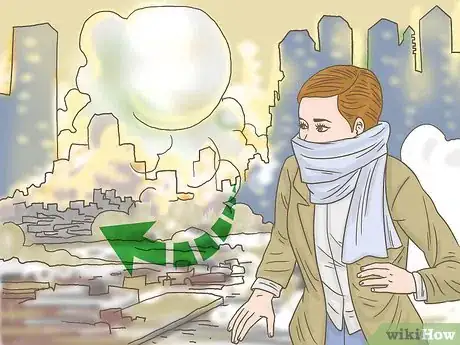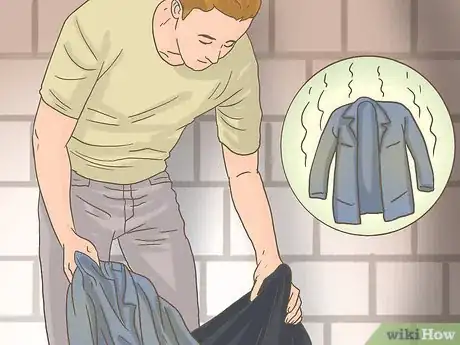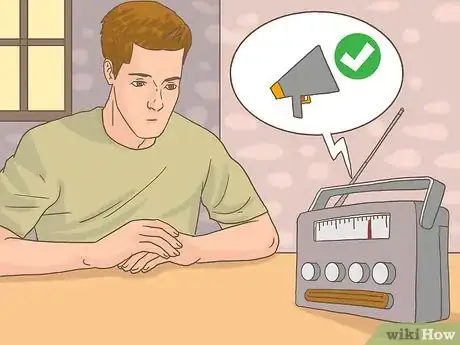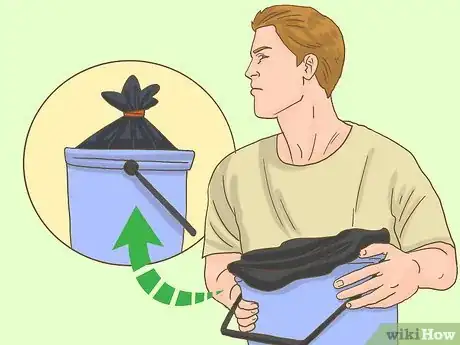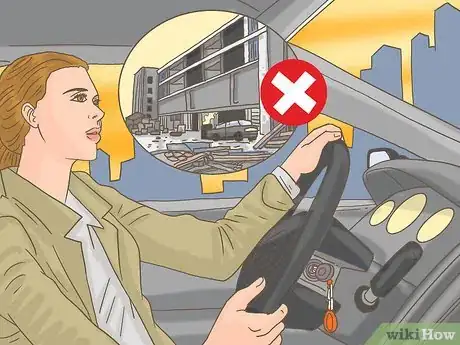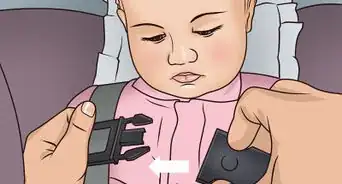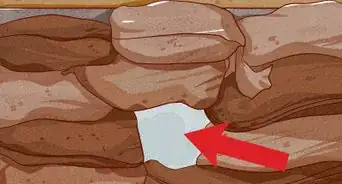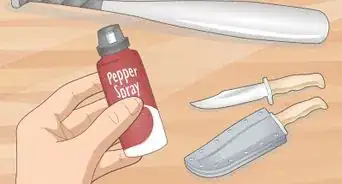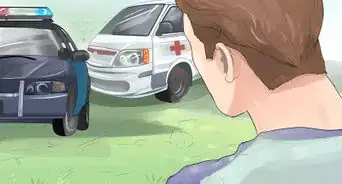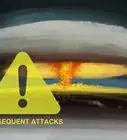This article was co-authored by wikiHow Staff. Our trained team of editors and researchers validate articles for accuracy and comprehensiveness. wikiHow's Content Management Team carefully monitors the work from our editorial staff to ensure that each article is backed by trusted research and meets our high quality standards.
There are 13 references cited in this article, which can be found at the bottom of the page.
This article has been viewed 57,178 times.
Learn more...
Fallout is radioactive debris produced by a nuclear explosion that can affect areas far away from the blast site. If you’re in a radiation emergency, do your best to get indoors as soon as possible. Preferably, seek shelter in the basement of a solid brick or concrete building. Try to stay calm, tune to your local emergency broadcast channel, and follow all instructions provided by the authorities. Unless you’re advised to evacuate, stay put until you’re told it’s safe to go outside.
Steps
Responding to the Immediate Blast
-
1Lie flat, turn away from the flash, and take cover if you’re near the blast. If possible, take cover behind anything that might offer protection. Lie face down, close your eyes, and put your hands over your head and face. The flash from a nuclear explosion is blinding, so do not look at or face the explosion if you’re near the blast site.[1]
- If you’re in a vehicle, pull off the road, come to a stop, duck down, and cover your head and face.[2]
-
2Cover your nose and mouth with a cloth if you’re outside. If you don’t have a clean cloth, use the inside of your undershirt. Keep your nose and mouth covered until you can get to an indoor shelter.[3]
- Covering your nose and mouth helps minimize the amount of radioactive particles you inhale.
Advertisement -
3Flee if a visible cloud of debris is traveling towards you. If dust or debris is heading your way, evacuate in a direction perpendicular to the cloud’s path. For instance, if the cloud is approaching from the north, go east or west.[4]
Safety tip: Evacuate only if there’s an obvious debris cloud or if instructed by authorities. If you're not within the immediate vicinity of the blast, the safest place to be is usually indoors. Buildings, brick and concrete structures in particular, can block significant amounts of harmful radiation.[5]
-
4Get to a brick or concrete building if there’s no obvious debris cloud. Shelter in place if you haven’t been instructed to evacuate. Preferably, head to the basement of a solid brick or concrete building. If you know the direction of the prevailing winds, take shelter on the opposite side of the structure away from doors and windows.[6]
- For instance, if winds in your area usually blow from northwest to southeast, head to the southeast corner of the building.
- Try to find the nearest brick or concrete building within 10 minutes. If no brick or concrete building is available, seek shelter in a structure with a basement. If that’s not possible, head to a windowless interior room.
Sheltering in Place
-
1Shut off ventilation systems and seal doors and windows with duct tape. To minimize contamination, turn off your building’s heat or air conditioning systems. Close and lock all doors and windows, and shut your fireplace’s dampers, if you have one. If you have time and duct tape is handy, use it to seal cracks around doors and windows.[7]
- Sealing the building can reduce your shelter’s exposure to radioactive fallout.
- Depending on your distance from the blast site, you may have 10 minutes or more to take shelter and seal the building. If you have a battery-operated or hand-cranked radio, follow your local authorities' instructions on sheltering in place.
-
2Remove your outer clothes and store them in sealed bags. Take off your outer garments carefully to avoid scattering radioactive material. Place them in tightly sealed bags or containers, and store the containers away from other people, pets, and packaged food and water.[8]
- Quarantining outer layers of clothing can remove up to 90% of radioactive contamination.
-
3Take a shower or gently wash your skin with soap and warm water. If you have access to a shower, rinse off with warm water and gently wash yourself with soap. Otherwise, wash with any available water source. Additionally, wipe your eyelids, eyelashes, and ears and blow your nose to remove radioactive residue.[9]
- Don’t scrub hard, as damaging your skin could allow radioactive particles to enter your body. If you have an open wound, cover it with a bandage before washing yourself to keep radioactive particles from entering it.
- Tap water is unsuitable to drink, but you can use it to decontaminate yourself. Any radioactive material in tap water is diluted, so it's safe to use for bathing.
- Wash your hair with shampoo, but don’t use conditioner, which will make radioactive particles stick to your hair and body.
Wash your pets, too: If any of your pets were outside and potentially exposed to radiation, wash them with soap and warm water. If possible, wear gloves and cover your face with a mask, cloth, or towel when decontaminating your pets or other people, such as your kids.[10]
-
4Consume packaged food and bottled water only. Do not drink tap water or eat unpackaged foods that were outdoors during the radiation emergency. Consume only packaged products that were stored inside, and store food and water in shielded containers. Even if power is off, the refrigerator should help shield food and water from radiation exposure.[11]
- Wash your hands with soap and warm water before eating and drinking.
- It’s wise to have a 3-day emergency supply of non-perishable food and water at all times in the event of a disaster situation.
-
5Stay inside until the authorities say it’s safe to go outside. Radioactivity levels are highest within the first few hours of a nuclear explosion. After about 8 hours, radioactivity levels will drop by about 90%; stay in the basement or an interior, windowless room during that time. You may need to stay inside for at least 24 to 48 hours.[12]
- Do not go outside until the authorities have given the clear. Listen for instructions on your battery-operated or hand-cranked radio, if you have one. If not, see if you can access emergency information with another electronic device. When it's safe to do so, emergency responders may also enter the building searching for survivors.
-
6Seal and secure waste if public services aren't in operation. Depending on how long you need to shelter in place, waste management may become an issue. Wrap food scraps in plastic or foil, and place the wrapped scraps in a sealed container. If toilets aren't in operation and you're unable to leave your home, make a latrine using a bucket lined with a thick plastic bag.[13]
- Tie the bag tightly after using it, and dispose of it in a trash receptacle that seals tightly. Be sure to line the trash receptacle with a heavy-duty plastic bag.
- Keep waste receptacles away from food, water, and living areas. If you have rubbing alcohol on hand, use it to disinfect your hands. To sanitize surfaces, use a diluted bleach solution.
-
7Call emergency services if you're out of life-sustaining medication. Call for help if you need vital medication, such as insulin, or if you or someone nearby requires immediate medical attention. If phone lines are down or if emergency services can't respond, see if your neighbors can help or have the medication you require on hand.[14]
- Cover your face with a clean cloth, wear long sleeves and pants, and decontaminate yourself after seeking help from your neighbors.
- As a last resort, and only in life-threatening scenarios, go to the nearest medical facility. Once inside your vehicle, keep the windows up, stay alert, and do your best to steer clear of debris and damaged roadways.
Staying Safe in a Radiation Disaster
-
1Listen to the radio, television, or other available media for instructions. If possible, tune to your emergency broadcast channel and listen for evacuation alerts, suggested routes, and other instructions. If you can’t tune in to emergency alerts, stay inside until emergency responders have arrived.[15]
- If you’re instructed to evacuate, listen for the locations of nearby public shelters. If cell service is available and you live in the U.S., you could also text “SHELTER” and your zip code to 43362.[16]
- To prepare ahead of time, it's wise to find out if your local authorities have designated any nearby disaster shelters.
- Cell service, television, and electricity may be affected. To stay up to date, invest in a battery-operated or hand-cranked radio and tune to your local emergency broadcast channel.
-
2Create an emergency supply kit in advance. If you don't already have an emergency supply kit, gather any flashlights, extra batteries, non-perishable food, and bottled water on hand. You should also pack important medications, glasses or contacts, cash, and supplies for any pets you own. If you need to evacuate to a public shelter, grab these items, along with vital documents, such as your passport and bank account information.[17]
Emergency kit staples: Include a first aid kit, a battery-operated flashlight, cell phone chargers, and an emergency radio. Don’t forget a manual can opener and extra batteries. You should also pack sturdy shoes, a fresh change of clothes, and a warm blanket.[18]
-
3Avoid debris, downed power lines, and other hazards if you need to flee. If local authorities have specified an evacuation route, follow their instructions. Don’t take shortcuts, which may be blocked. Steer clear of unsound or fallen buildings, keep your eye out for road damage, and do not approach downed power lines, which may be live.[19]
- When you hit the road, keep your vehicle's windows closed to minimize radiation exposure. Additionally, close the vents and avoid turning on the air conditioner or heat.[20]
-
4Communicate with friends and family, if possible. In the immediate aftermath, leave telephone lines open for emergency services. Cell phone service may also be limited or unavailable. Once you reach shelter, contact loved ones if you have service and authorities have said it’s okay.[21]
- If you need to contact a loved one soon after the event, send them a text or email instead of calling them.[22]
- After evacuating, don’t return to the contaminated area until the authorities have given the clear.
Community Q&A
-
QuestionShould I eat my family if they die?
 Lucas BenavidesCommunity AnswerNo. You could get a really bad disease. Also, it is going to be very bad for your reputation.
Lucas BenavidesCommunity AnswerNo. You could get a really bad disease. Also, it is going to be very bad for your reputation. -
QuestionWhich area is safer to shelter in place - a basement that is rock not concrete and has windows, or a windowless bathroom inside the house?
 Mb_e6e67c536020Community AnswerThe basement. The dirt around it will also protect from radiation, along with the stone. Always try to stay in the middle though, because there can still be small amounts of radiation near the walls. If you can, try putting a bathroom in your basement as well. This will make it less risky to use the bathroom.
Mb_e6e67c536020Community AnswerThe basement. The dirt around it will also protect from radiation, along with the stone. Always try to stay in the middle though, because there can still be small amounts of radiation near the walls. If you can, try putting a bathroom in your basement as well. This will make it less risky to use the bathroom.
Warnings
- Don’t take potassium iodide or any other medication for the treatment of radiation exposure without consulting a medical professional.[25]⧼thumbs_response⧽
References
- ↑ https://emergency.cdc.gov/radiation/nuclearfaq.asp
- ↑ https://www.ready.gov/nuclear-explosion
- ↑ https://www.dhs.gov/xlibrary/assets/prep_nuclear_fact_sheet.pdf
- ↑ https://www.dhs.gov/xlibrary/assets/prep_nuclear_fact_sheet.pdf
- ↑ https://t.cdc.gov/synd.aspx?js=0&rid=cs_639&url=http://t.cdc.gov/ILO#6
- ↑ https://www.ready.gov/nuclear-explosion
- ↑ https://www.dhs.gov/xlibrary/assets/prep_nuclear_fact_sheet.pdf
- ↑ https://emergency.cdc.gov/radiation/selfdecon_wash.asp
- ↑ https://emergency.cdc.gov/radiation/selfdecon_wash.asp
- ↑ https://t.cdc.gov/synd.aspx?js=0&rid=cs_639&url=http://t.cdc.gov/ILO#13
- ↑ https://www.ready.gov/nuclear-power-plants
- ↑ https://www.dhs.gov/xlibrary/assets/prep_nuclear_fact_sheet.pdf
- ↑ https://www.who.int/water_sanitation_health/hygiene/emergencies/em2002chap8.pdf
- ↑ https://nepis.epa.gov/Exe/ZyNET.exe/P100SAKO.txt?ZyActionD=ZyDocument&Client=EPA&Index=2016%20Thru%202020&Docs=&Query=&Time=&EndTime=&SearchMethod=1&TocRestrict=n&Toc=&TocEntry=&QField=&QFieldYear=&QFieldMonth=&QFieldDay=&UseQField=&IntQFieldOp=0&ExtQFieldOp=0&XmlQuery=&File=D%3A%5CZYFILES%5CINDEX%20DATA%5C16THRU20%5CTXT%5C00000006%5CP100SAKO.txt&User=ANONYMOUS&Password=anonymous&SortMethod=h%7C-&MaximumDocuments=1&FuzzyDegree=0&ImageQuality=r75g8/r75g8/x150y150g16/i425&Display=hpfr&DefSeekPage=x&SearchBack=ZyActionL&Back=ZyActionS&BackDesc=Results%20page&MaximumPages=1&ZyEntry=3
- ↑ https://emergency.cdc.gov/radiation/nuclearfaq.asp
- ↑ https://www.ready.gov/nuclear-power-plants
- ↑ https://emergency.cdc.gov/radiation/nuclearfaq.asp
- ↑ https://www.ready.gov/build-a-kit
- ↑ https://www.ready.gov/evacuating-yourself-and-your-family
- ↑ https://www.ready.gov/nuclear-power-plants
- ↑ https://www.ready.gov/evacuating-yourself-and-your-family
- ↑ https://emergency.cdc.gov/radiation/staytuned.asp
- ↑ https://www.dhs.gov/xlibrary/assets/prep_nuclear_fact_sheet.pdf
- ↑ https://emergency.cdc.gov/radiation/staytuned.asp
- ↑ https://www.nrc.gov/reading-rm/doc-collections/fact-sheets/fs-dirty-bombs.html
About This Article
In the event of a nuclear explosion, turn away from the flash to protect your eyesight and take cover if you’re near the blast. Lie face down, close your eyes, and put your hands over your head and face. If you’re outside, cover your mouth and nose with a cloth or your shirt to reduce the amount of radioactive particles you inhale. You should only evacuate the area if you see a visible cloud of debris traveling towards you. Otherwise, get to a brick or concrete building as soon as possible to reduce your radiation exposure. Once you’re inside, do what you can to seal the building to further reduce exposure. Close and lock all windows and doors, shut any fireplace dampers, turn off central air systems, and use duct tape to close any remaining gaps. Take off your contaminated outer garments and place them in tightly sealed containers. If you can, take a shower and gently wash your skin with soap and warm water, but do not drink any water from the shower or tap. Wipe your eyelids, eyelashes, and ears, and blow your nose to remove radioactive residue. From inside your shelter, listen for instructions from authorities on a radio if you have one. You may need to stay inside for at least 24 to 48 hours. For more nuclear fallout survival tips, like how to minimize radiation exposure inside a vehicle, keep reading!


